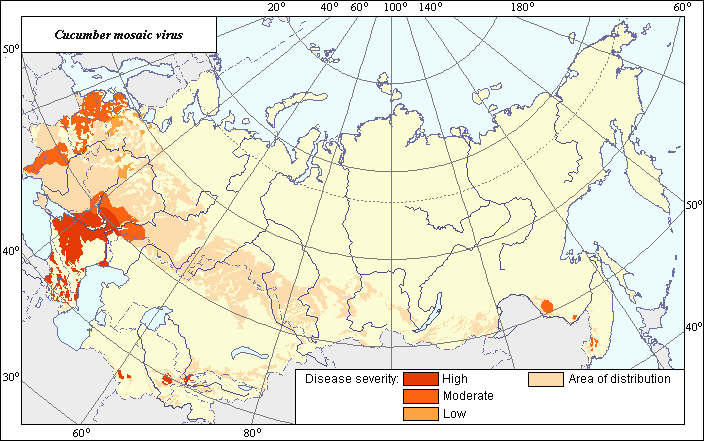Diseases
Distribution and severity zones of Cucumber Mosaic Virus .
 Object description Download GIS-layers
Object description Download GIS-layers
Authors:
Specialist-biologist .Tsyplenkov A.E.,GIS-specialist . Saulich M.I.
Date of creation:
18.08.2005Scale:
1: 20 000 000.Accuracy of map:
It is created on information taken from the map of scale 1: 33 000 000.Projection:
"Alber's Equal Area Conic for the USSR", 9, 1001, 7, 100, 0, 44, 68, 0, 0.Basic contents:
The vector map is composed of 4 thematic layers where area and severity zones are shown by polygons.Accuracy of the classifier:
The area of distribution is divided into three zones of severity according with Yu.I. Vlasov et al. (1973). In the zone of high severity, the disease development on gourd and solanaceous cultures is 30-50% or more and epiphytoties are frequent; in the zone of moderate severity the Cucumber Mosaic Virus epiphytoties appear every 6th or 7th year; in the zone of low severity the disease development is 10% or less.Procedure of the map drawing:
Zones of severity are drawn on a blank map based on published references. The zone of high severity includes Republics of Central Asia, Lower Volga region, the Northern Caucasus, Krasnodar Territory, Rostov Region (Vlasov et al., 1972; Parshin, 1974; Glushak, 1969; Tsyplenkov et al., 1992; Samsonova et al., 2001). The zone of moderate severity includes Byelorussia, Moldova, Baltic States and also same regions of Ukraine and Khabarovsk Territory (Ignash, 1977; Ges., 1968; Stanyulis et al., 1977; Dashkeeva et al., 1968). The CMV disease distribution in other territories (including Northwestern region) does not exceed 10-15% (Tsyplenkov, 1986). A correction of the area and disease severity zones is executed according to Koroleva. vector map of the largest distribution areas of arable lands (Koroleva et al., 2003) with regard for the cucumber area contours by Terekhina map (Terekhina, 2005).Sources of data:
Vlasov Yu.I., Larina E.I., Teploukhova T.N. 1972. Virus diseases of tomatoes in Central Asia and measures of their control. Bulletin VIZR (Leningrad) 24: 58-62 (in Russian).Ges. D.K. 1968. Virus diseases of tomatoes and cucumbers in Byelorussia. PhD Thesis. Minsk: AN BSSR, 22 p. (in Russian).
Glushak L.E. 1969. Virus diseases of cucumbers in Ukraine. PhD Thesis. Kiev: UkrNII Microbiology, 23 p. (in Russian).
Dashkeeva K.N.,Vargina T., Vetrova F. 1968. Cucumber Mosaic Virus . agent of diseases of vegetable cultures. Sel.skoe khozyaistvo Moldavii 6: 51-52 (in Russian).
Ignash Ya.R. 1977. Comparative characteristic of some representatives of Cucumber Mosaic Virus group 1, isolated in Latvian SSR. In: Reifman V.G., ed. Strains of plant viruses. Proc. Biol.-soil Inst, v.48(149), p.193-197 (in Russian).
Parshin V.G. 1974. Natural foci of Cucumber Mosaic Virus and their significance in development of virus epiphytoties. PhD Thesis. Leningrad: VIZR, 23p. (in Russian).
Samsonova L.N., Tsyplenkov A.E. & Yakutkina T.A. 2001. Diagnostics of virus and phytoplasma diseases of vegetable cultures and potato. Saint-Petersburg: VIZR, 50 p. (in Russian).
Stanyulis Yu.P., Makunaite M.K., Zitikaite I.S. 1977. Some properties of virus isolates of the cucumber mosaic (CMV), allocated from leguminous and ornamental plants in Lithuania. In: Reifman V.G., ed. Strains of plant viruses. Proc. Biol.-soil Inst, v.48(149), p.198-203 (in Russian).
Tsyplenkov A.E. 1986. Study of pathogenicity virus isolates of cucumber mosaic. In: redaktor Biological methods of plant protection against virus and bacterial diseases. Leningrad: VIZR, p.49 (in Russian).
Right and copyright:
All rights reserved. Copyright 2005 © A.E. Tsyplenkov & M.I.Saulich (vector map, description).Picture is taken from Samsonova L.N., Tsyplenkov A.E. & Yakutkina T.A. (2001).

